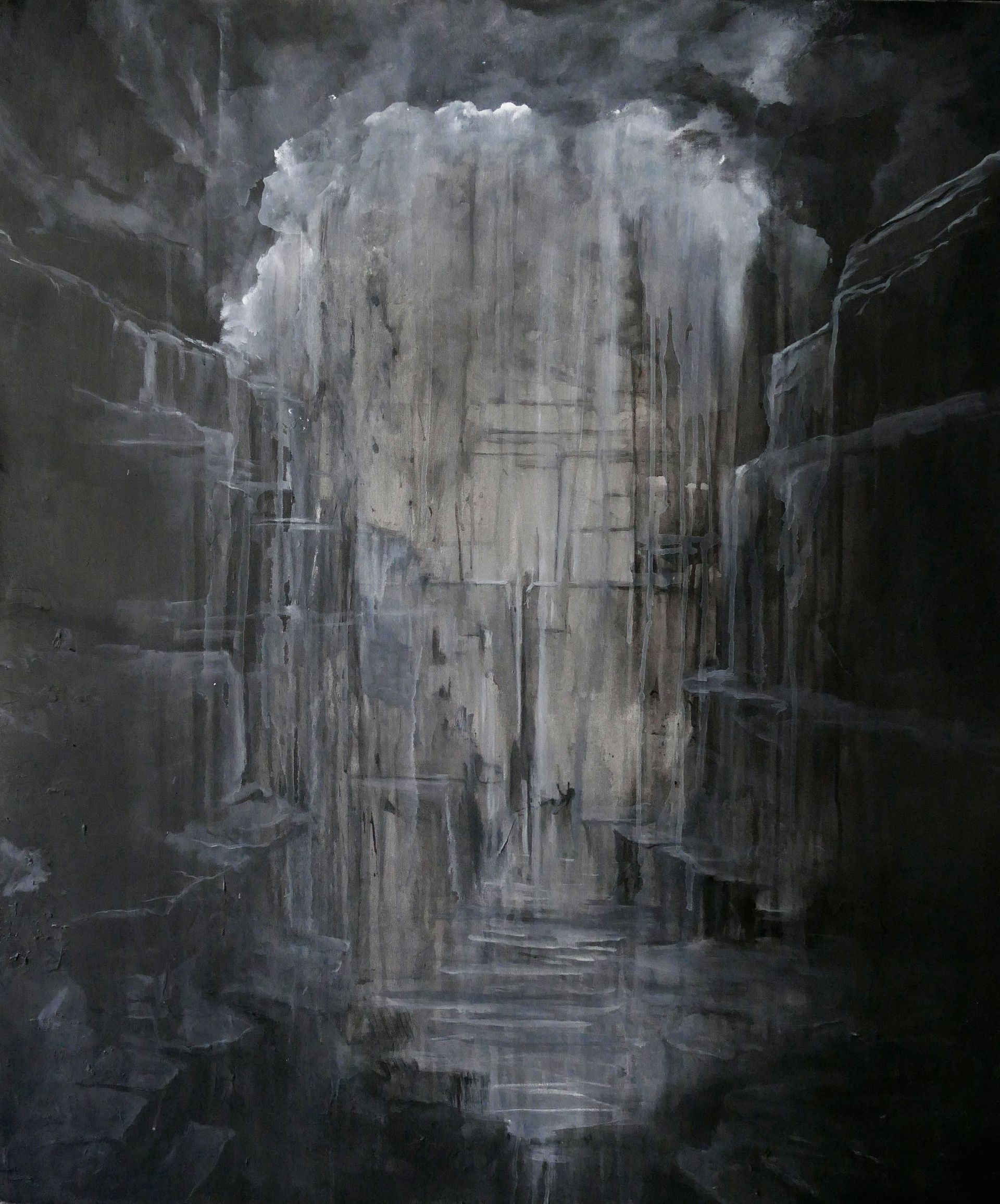
The Fall (2025)
The Fall emerged from an intuitive process immediately after a trauma therapy
(EMDR) session, painted the day after my sister’s death. Created in an intense emotional state, the work became both a container and a conduit for the overwhelming and inexpressible experience of grief. Paint flowed down the canvas, forming a waterfall-like cascade. Dripping of paint and water and gestural mark-making represent a somatic release, aligning with trauma theory that traumatic memory is often stored in the body and may be accessed or discharged through physical expression. (Van der Kolk, 2015)
Loose and gestural painting at the centre of the work symbolises the unconscious and Nietzsche’s Dionysian, uncontrolled matter. Surrounding this, the painting is more defined; rocks with a stormy sky overhead and water below, represent structure and symbolic containment, reflecting the Apollonian principle of imposing order on chaos.(Nietzsche, 2012) Tension between chaos and order aligns with Jung's concept of individuation (Jung, Hull, & Jung, 2007), which involves the integration of opposites, specifically the alchemical coniunctio oppositorum. (Jung and Jung, 1977) Iain McGilchrist’s theory of hemispheric integration (McGilchrist, 2021) correlates with these concepts of Nietzsche and Jung.
Using the same technique as in the painting Nigredo, layers of drawing and paint were separated with transparent gesso and varnish, creating visual depth that reflects the complex layers of grief and repressed traumatic memory. The descending vertical lines and fragmented forms suggest collapse, dissolution, and downward movement. There is a weight and sense of falling in the painting.
The central figure, falling and suspended in the waterfall, represents a chthonic journey into the unconscious, symbolising the initial alchemical stage of transformation, the nigredo. (Jung and Jung, 1977) Nigredo signifies a descent into darkness and psychic death, a katabasis and dark night of the soul (John of the Cross, Peers, and Silverio, 2003) which occurs before transformation. The waterfall and the falling figure symbolise a liminal space.
The cave-like interior that opens to the tumultuous sky above symbolises the alchemical crucible as a psychic container. The crucible represents a process of purification through trial and dissolution, where elements are broken down. The container reflects trauma theory’s emphasis on the importance of safe environments to heal and contain the fragmented self. (Moskowitz, 2007) Openness suggests vulnerability and rupture, indicating that transformation occurs amid chaos and exposure within a liminal space for dissolution. The water’s flow through the crucible suggests cleansing, renewal and the movement of psychic material that cannot be contained, emphasising transformation as an ongoing, dynamic process.
The dramatic sky suggests a rupture into a transcendent or spiritual realm, referencing the sublime and Lacan’s Real, (Lacan and Lacan, 2004) where language and symbolic structures collapse, revealing the ineffable experience of trauma and grief. The Fall parallels the painting Nigredo in its exploration of fragmentation, dissociation, and the struggle for containment. It presents rupture as psychic death and a transformative threshold.
References.
John of the Cross, Peers, E.A. and Silverio (2003) Dark night of the soul. Mineola, N.Y: Dover Publications (Dover thrift editions).
Jung, C.G., Hull, R.F.C. and Jung, C.G. (2007) The archetypes and the collective consciousness. 2. ed., repr. London: Routledge (The collected works of C. G. Jung, 9,1).
Jung, C.G. and Jung, C.G. (1977) Mysterium coniunctionis: an inquiry into the separation and synthesis of psychic opposites in alchemy. 2d ed. Princeton, N.J: Princeton University Press (The collected works of C.G. Jung, v. 14).
Lacan, J. and Lacan, J. (2004) The four fundamental concepts of psycho-analysis. Reprinted. London: Karnac Books.
McGilchrist, I. (2021) ‘The Matter With Things 2023: Our Brains, Our Delusions, and the Unmaking of the World. Volume 2: What Then is True? / Iain McGilchrist’, in. London: Perspectiva Press.
Moskowitz, A. (2007) ‘The Haunted Self: Structural Dissociation and the Treatment of Chronic Traumatization. By Onnovan der Hart, Ellert R. S. Nijenhuis & Kathy Steele. W.W. Norton. 2006.416pp. $32.00 (hb). ISBN 0393704017’, British Journal of Psychiatry, 191(6), pp. 571–572. Available at: https://doi.org/10.1192/bjp.bp.107.036087.
Nietzsche, F. (2012) The Birth of Tragedy. Newburyport: Dover Publications (Dover Thrift Editions).
Van der Kolk, B.A. (2015) The body keeps the score: mind, brain and body in the transformation of trauma. London: Penguin Books.